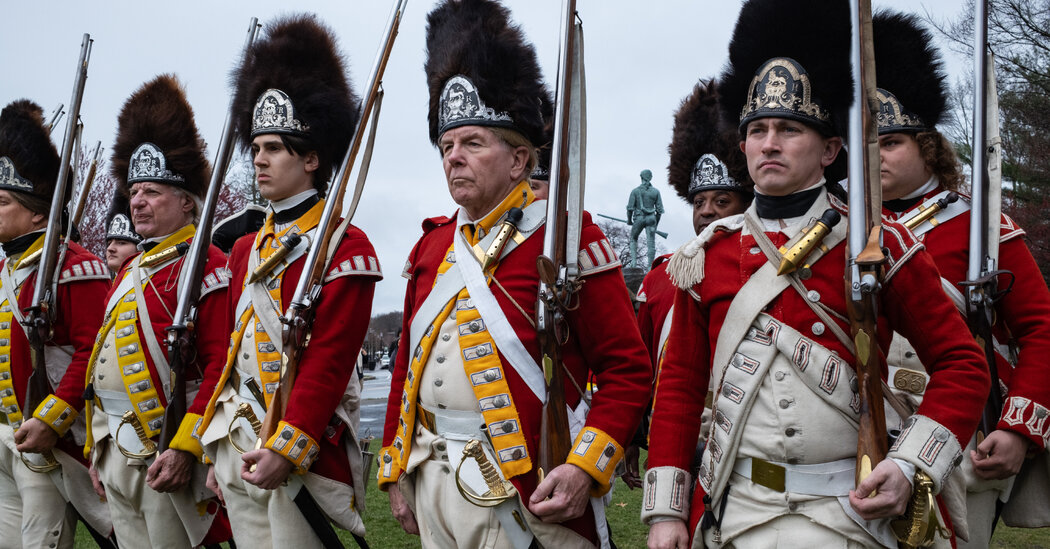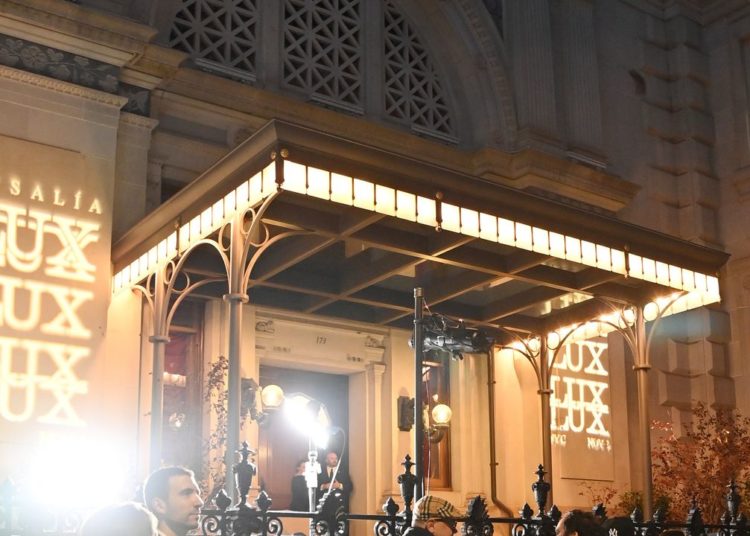Of all the moonlit nights in American history, one in particular has gripped the public imagination. On April 18, 1775, a 40-year-old Boston silversmith named Paul Revere borrowed a horse and sped west to warn his fellow colonists. A looming threat had spurred his urgent errand. The British were coming.
Exactly 250 years later, Revere’s midnight ride still resonates for many along his 16-mile route — a symbol of enduring American values, and a reminder of the heavy costs the country’s founders were willing to pay in pursuit of freedom and autonomy.
“It can’t be overstated, the risk that he was taking,” said Nikki Stewart, director of Old North Illuminated, the nonprofit that oversees historic Old North Church in Boston. “To leave the comfort and safety of his home, his wife and seven children, in the middle of the night — it’s a profound level of conviction.”
As a flurry of events kicked off this month, marking the 250th anniversary of the start of the American Revolution, we set out to retrace Revere’s route in Massachusetts, asking people along the way what his ride means to them — or if they even know about it.
At rain-swept intersections where protesters gathered, in cozy diners and on pristine town commons, we found people of all backgrounds who still felt a sense of awe about that April night, and who take deep pride in living in the place where America began.
1. NORTH END, BOSTON
Paul Revere House
On Friday night, on the second floor of the house where Revere lived, Michael Lepage, a history interpreter, will sit in a chair that was once Revere’s, lean over and pull on a pair of black leather boots.
With that, the city will begin its sestercentennial celebration of his midnight ride, and the battles that broke out the next day. At the door of the Revere home, now a museum with 250,000 annual visitors, Mr. Lepage will say goodbye to Revere’s wife, Rachel, portrayed by Judith Kalaora, and head out on his moonlit mission.
To Mr. Lepage, 59, who has played Revere for 20 years — using vacation time from his job as a clerk in a registry of deeds — the point is that the patriots were just like us.
A former groundskeeper and longtime history buff, Mr. Lepage is a font of lesser-known facts: Revere’s father, a French immigrant, anglicized their surname, Rivoire; Revere was court-martialed, and exonerated, after a failed expedition to capture a British fort; Revere built the country’s first mill capable of rolling copper into sheets, and it made him rich.
“He’s relatable,” Ms. Stewart said. “He was a child of immigrants, a father, a small-business owner.”
Of all his exploits, though, Revere’s midnight ride is the secret sauce for history teachers, an anecdote so action-packed and gripping, it borders on unforgettable.
“Let’s face it,” Mr. Lepage said. “You can’t find a more exciting historical story.”
2. HANOVER STREET, BOSTON
Paul Revere Statue
After leaving home that night around 10:30 p.m., Revere crossed the neighborhood to its waterfront. There he met two friends who rowed him across the Charles River, quietly passing an anchored British warship.
Nowadays, countless Boston tourists wander the well-trodden path from Revere’s house to the statue of Revere on horseback that towers nearby, on Hanover Street — with a stop for cannoli at a local pastry shop, in the neighborhood now known as Boston’s Little Italy. David Grube was among them on a recent Friday.
“Paul Revere is part of why we came here,” said Mr. Grube, 31, a first-time visitor to Boston traveling with childhood friends from Watertown, S.D.
Standing before the statue, wearing a $12 souvenir tricorn hat, Mr. Grube marveled at Revere’s courage.
“To stand up against that tyrannical force,” he said. “To be that one person, standing alone, so others will join in. And that’s what happened.”
3. charlestown
Revere Borrows a Horse
In Charlestown, where Revere’s boat landed, he hastened to pick up his borrowed horse from a local merchant. Now a part of Boston, but then a separate town, Charlestown was burned to the ground by the British two months later, in June 1775, during the Battle of Bunker Hill.
4. SOMERVILLE
Winter Hill
Atop his horse by about 11 p.m., Revere rode northwest, to what is now the Winter Hill neighborhood of Somerville. He would have passed farmland and rambling stone walls. Today, his route cuts through a vibrant neighborhood of modest triple-deckers, old-school pizza joints, an Indian grocery, a craft beer taproom and a community center where Haitian immigrants learn English.
Sissy Doherty, 55, eating pizza at Alfredo’s on a Friday afternoon with her 5-year-old granddaughter, Summer, said she grew up in the neighborhood, watching the re-enactment of Revere’s ride every April. She said she received a solid grounding in American history, but fears that students today may not learn as much history as they used to.
“I don’t think they teach the history anymore,” she said, “like they don’t teach handwriting.”
Across the street, Daylis Alonzo, 32, and his girlfriend, Mary McGarr, 26, had just eaten at Dumpling Garden, an Asian restaurant on the route. Mr. Alonzo said he had learned plenty of history, including Revere’s, at Snowden International School, a public high school in Boston.
5. SOMERVILLE
Spin Cycle Laundromat
A half-mile down Broadway, in tiny Paul Revere Park, an unassuming stone marker that’s easily overlooked offers a reminder that Revere “passed over this road.” In the laundromat across the street, an attendant, William Faber, 61, said the history of the spot felt keenly present on quiet nights when he stood sentry by the open door.
“It’s amazing knowing that he came this way,” he said.
6. MEDFORD
Islamic Cultural Center of Medford
Revere rode into Medford around 11:30 p.m., and briefly stopped on High Street at the clapboard home of Capt. Isaac Hall, commander of the Medford Minutemen. Today, the house where Hall lived belongs to the Islamic Cultural Center of Medford.
Built in 1720, the structure had been a funeral home for more than a century, and then sat vacant, in increasing disrepair, before the city’s growing Muslim community sought it out. Initially they faced suspicion, said Humayun Morshed, the center’s president, from some who worried they might disregard the building’s history.
Those concerns have faded, as the mosque’s leaders have made improvements to the building. They help host a downtown celebration on Patriots’ Day every April, including a reading of Longfellow’s poem about Revere. Mr. Morshed’s 16-year-old son, Adib, who is in 11th grade and wants to be a lawyer, reads a section of the poem, dressed in colonial costume.
“We want to celebrate the Islamic history, and the American history,” said Mr. Morshed, who immigrated to the United States from Bangladesh.
As the 9 p.m. adhan, the Islamic call to prayer, echoed through the building’s 18th-century rooms, Mr. Morshed said he was grateful to be there.
“We live in the best place on the planet,” he said, “and it’s for everyone.”
7. WEST MEDFORD
Paul Revere Restaurant
To the consternation of historians, most Americans know only one midnight rider. But at the Paul Revere Restaurant, a mile down High Street on Revere’s route, the other riders who risked their lives that night get their due. Diners can order the Paul Revere (three eggs), the William Dawes (two eggs) or the Samuel Prescott (biscuits with sausage gravy).
Riley Cantrell, a Medford fifth-grader perched at the counter one recent Saturday morning, ordered her usual: a chocolate chip pancake bigger than her face, a side of bacon and pink lemonade.
Her father, David Cantrell, said Revere’s ride felt freshly relevant today, as people weigh the risks of speaking out.
To Ms. Cantrell, 11, beaming at the counter, the proximity to Revere’s route felt like a privilege, enough to give her small city just a hint of swagger.
“People all around the country learn this history,” she said. “But we’re the ones who get to see it every day.”
8. ARLINGTON & Lexington
Protests Against President Trump
As he galloped through the village of Menotomy — now the city of Arlington, nine miles northwest of Boston — Revere passed near a meeting house, a tavern and the home of Jason Russell, a farmer who would be killed the next day in a bloody battle on his land as the British retreated from Lexington back to Boston.
When we traveled the same way, on a rainy Saturday this month, we saw crowds protesting President Trump at busy intersections in Arlington and Lexington. At Mystic Street and Massachusetts Avenue in Arlington, some invoked the revolutionary history of the spot, and said the past bravery of Revere, Russell and others had inspired them to join the demonstration.
9. LEXINGTON
Hancock-Clarke House
As he sped toward Lexington, now about eight miles away, Revere was closing in on his destination, the home of the Reverend Jonas Clarke, where Samuel Adams and John Hancock were staying while attending meetings in nearby Concord. Warning the two leaders of the Sons of Liberty was Revere’s prime purpose; he did so around 12:30 a.m., after convincing the suspicious guards outside the house to let him in.
If Revere had hoped that his success that night would elevate his status, and cement his equal standing with the patriot elites, he was disappointed, said Nina Zannieri, a historian who runs the Paul Revere House in Boston. Even after the midnight ride, he hovered just outside the inner circle.
“He’s not in the room,” Ms. Zannieri said, “and it rankles him.”
10. LExington
Battle Green
Soon after he left Lexington, around 1:30 a.m., and rode on toward Concord with two other men, the danger that Revere had so far dodged caught up with him. Confronted by a British patrol about halfway to Concord, his companions escaped but Revere was captured, held and questioned. Unlikely as it seems, the soldiers let him go about an hour later, after being rattled by the sound of distant gunfire, Revere would later write.
Undaunted — but now without his horse, which the British had kept — Revere walked about three miles back to Lexington and rushed to complete his next assignment, rescuing a trunk full of Hancock’s papers from the Buckman Tavern, next to the town common, where the first battle of the war would soon erupt.
The first shots rang out around dawn, after British soldiers marched onto the common and faced off with the local minutemen.
Today, the common is known as the Battle Green, a swath of grass that historians consider hallowed ground. When re-enactors assembled there one recent Sunday to stage a dress rehearsal for the 250th anniversary, Diana Mokler stood among the spectators, watching mesmerized as the two sides faced off again.
Ms. Mokler, 74, lives nearby, but had never come to see a re-enactment. This year, she said, it felt important to be there, to pause and reflect, given the unrest in the country.
“Seeing this, it’s more powerful than words,” she said. “It reminds us what our forefathers fought for, and that we need to make sure it never gets destroyed.”
Jenna Russell is the lead reporter covering New England for The Times. She is based near Boston.
Todd Heisler is a Times photographer based in New York. He has been a photojournalist for more than 25 years.
The post Riding Paul Revere’s Route 250 Years Later, Here’s What We Saw appeared first on New York Times.




